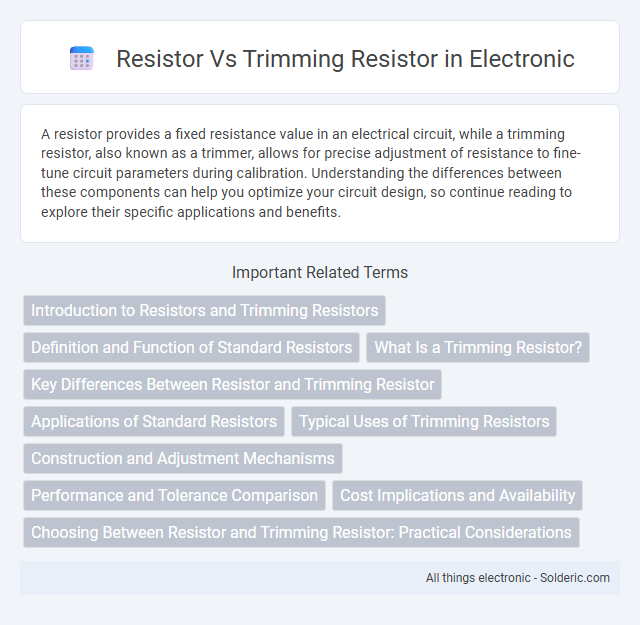A resistor provides a fixed resistance value in an electrical circuit, while a trimming resistor, also known as a trimmer, allows for precise adjustment of resistance to fine-tune circuit parameters during calibration. Understanding the differences between these components can help you optimize your circuit design, so continue reading to explore their specific applications and benefits.
Comparison Table
| Feature | Resistor | Trimming Resistor |
|---|---|---|
| Purpose | Limits current, divides voltage | Fine-tunes resistance for calibration |
| Adjustability | Fixed value | Variable; can be adjusted during setup |
| Precision | Standard tolerance (+-1%, +-5%) | High precision; typically +-0.1% or better |
| Use Case | General electronic circuits | Calibration and tuning circuits |
| Types | Carbon film, metal film, wire wound | Potentiometer, trimmer capacitor, multi-turn resistor |
| Size | Small, standardized packages | Usually compact, with adjustment screw |
| Cost | Lower cost | Higher cost due to adjustability |
Introduction to Resistors and Trimming Resistors
Resistors regulate electrical current by providing a specific resistance value in circuits, typically fixed and designed for stable performance. Trimming resistors, also known as adjustable or variable resistors, allow fine-tuning of resistance during manufacturing or calibration processes to optimize circuit functionality. These precision components are essential in applications requiring exact resistance adjustments to ensure accurate signal levels and performance characteristics.
Definition and Function of Standard Resistors
Standard resistors are fixed-value components designed to limit electric current and divide voltage within circuits. Their stable resistance properties provide precise control over current flow, ensuring reliable performance in electronic devices. You can rely on standard resistors for consistent operation, unlike trimming resistors which are adjustable and used for calibration purposes.
What Is a Trimming Resistor?
A trimming resistor is a precise, adjustable resistor used to fine-tune circuit parameters during calibration or testing, providing exact resistance values within a limited range. Unlike fixed resistors that have constant resistance, trimming resistors allow for incremental adjustments to optimize circuit performance and achieve desired electrical characteristics. They are commonly used in applications requiring high accuracy, such as sensor calibration, voltage regulation, and circuit balancing.
Key Differences Between Resistor and Trimming Resistor
A resistor provides a fixed resistance value crucial for controlling current and voltage in basic electronic circuits, while a trimming resistor (or trimmer) allows precise adjustment of resistance during calibration or fine-tuning of circuits. Unlike standard resistors, trimming resistors are often adjustable potentiometers or variable resistors designed for optimization and compensation of component tolerances. Key differences include stability, with fixed resistors offering consistent resistance versus the customizable, user-tuned resistance of trimming resistors used mainly in prototype and precision applications.
Applications of Standard Resistors
Standard resistors are widely used in electronic circuits for current limiting, voltage division, and signal conditioning due to their fixed resistance values and reliability. They are essential in applications such as power supplies, amplifiers, and digital electronics where consistent resistance is required for stable circuit performance. Unlike trimming resistors, which are adjustable and primarily used for calibration and fine-tuning, standard resistors provide cost-effective and stable resistance for mass-produced electronic devices.
Typical Uses of Trimming Resistors
Trimming resistors are primarily used for fine-tuning circuit parameters in applications such as calibration, sensor offset adjustment, and precise gain control in amplifiers. They enable accurate tuning of resistance values after initial circuit assembly, improving overall system performance and reliability. These resistors are often found in analog circuits, instrumentation systems, and feedback control loops where exact resistance values are critical.
Construction and Adjustment Mechanisms
A resistor typically consists of a fixed resistance element made from carbon film, metal oxide, or wire wound on an insulating core, designed to provide a stable and unchanging resistance value. A trimming resistor, also known as a trimmer, incorporates an adjustable wiper mechanism that slides over a resistive track, enabling fine-tuning of resistance during calibration or testing. The construction of trimmers allows precise manual or automated adjustment of resistance values, whereas standard resistors lack any built-in mechanism for modification after manufacturing.
Performance and Tolerance Comparison
Resistors typically offer standard tolerance ranges of +-1% to +-5%, providing stable and consistent resistance values for general applications, while trimming resistors feature adjustable resistance with tighter tolerance adjustments, often less than +-0.1%, enabling precise calibration in circuits. Performance-wise, trimming resistors excel in fine-tuning and compensating for circuit variations, which is critical in high-precision analog and measurement systems. Standard resistors prioritize cost-effectiveness and long-term stability, whereas trimming resistors prioritize customization and accuracy during manufacturing or calibration processes.
Cost Implications and Availability
Standard resistors generally offer lower cost and wider availability due to mass production and common specifications, making them a cost-effective choice for most applications. Trimming resistors, designed for fine-tuning and precision adjustments, tend to be more expensive and less readily available, reflecting their specialized use in calibration and prototype settings. You should consider the balance between precision requirements and budget constraints when choosing between these resistor types.
Choosing Between Resistor and Trimming Resistor: Practical Considerations
Choosing between a resistor and a trimming resistor depends on the level of precision and adjustability required in your circuit. Standard resistors provide fixed resistance values ideal for stable, consistent performance, while trimming resistors offer fine-tuning capabilities to calibrate voltage, current, or signal levels during testing or maintenance. Your decision should consider factors such as tolerance, application environment, and the necessity for post-installation adjustments to achieve optimal circuit functionality.
resistor vs trimming resistor Infographic

 solderic.com
solderic.com